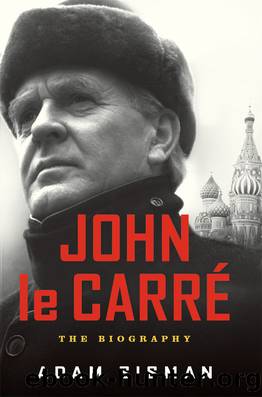John le Carre: The Biography by Adam Sisman

Author:Adam Sisman [Sisman, Adam]
Language: eng
Format: azw3
Publisher: HarperCollins
Published: 2015-11-02T16:00:00+00:00
For David, writing has been both a vent for the unrest within him and a source of misery. It has provided him with fulfilment and frustration. It is often a way for him to bring himself up again out of depression. He recognises that he is obsessive about his work, that it is a kind of âjoint madnessâ into which he has drawn Jane. Spells of over-excitement about what he has written have been followed by periods when none of it has pleased him.
Davidâs new book was planned as the first in a sequence of interlinked novels. He talked of seven, or even more: perhaps as many as ten or fifteen.8 The overall theme would be the struggle between the Circus and the KGB, in particular the contest between George Smiley and Karla, the mysterious and apparently all-powerful head of the âThirteenth Directorate of Moscow Centreâ. The âThirteenth Directorateâ was an imaginary body, though âMoscow Centreâ was real slang used by KGB agents themselves.
For David, the actions of the intelligence services revealed the true, hidden nature of the state they represented. The Circus was England in miniature, looking back with nostalgia and contemplating the future with foreboding. Smileyâs generation of senior officers, now approaching retirement, had been among Englandâs most gallant knights in the crusade against Nazism; their reward had been to see their country reduced to the status of a second-class power, humiliatingly subservient to America. âPoor loves,â laments a drunken Connie Sachs, the Circusâs dismissed head of research. âTrained to Empire, trained to rule the waves. All gone. All taken away. Bye-bye world.â She is nostalgic for a golden past, of the exploits of courageous young men; she does not want to hear that one of them might have betrayed his country. âI want to remember you all as you were. Lovely, lovely boys.â
Taken as a whole, therefore, the sequence of novels provided an opportunity to train a light not just on the secret state but on the state itself, in its painful attempt to come to terms with its post-imperial role. This was a scheme that went far beyond the limits of the genre, on the scale of similarly ambitious projects in post-war fiction by such âliteraryâ writers as Paul Scott, Anthony Powell and C. P. Snow.9 Once again Davidâs inspiration was Balzac. âI had originally intended to do an espionage Comédie humaine of the SmileyâKarla stand-off, and take it all over the world,â he would tell an interviewer in 2002, âa kind of foolâs guide to the Cold War.â This of course was a throwaway comment: his real aim was to examine the state of the nation, by exposing its secret underside.
It is revealed in the opening pages of the first novel that there is a Soviet âmoleâ at the heart of British intelligence, controlled by Karla. âA mole is a deep penetration agent so called because he burrows deep into the fabric of Western imperialism,â explains Irina, an unhappy Russian agent wanting to defect. The unidentified mole, code-named âGeraldâ, is said to be âa high functionary in the Circusâ.
Download
This site does not store any files on its server. We only index and link to content provided by other sites. Please contact the content providers to delete copyright contents if any and email us, we'll remove relevant links or contents immediately.
The Secret History by Donna Tartt(18216)
The Social Justice Warrior Handbook by Lisa De Pasquale(11960)
Thirteen Reasons Why by Jay Asher(8468)
This Is How You Lose Her by Junot Diaz(6458)
Weapons of Math Destruction by Cathy O'Neil(5848)
Zero to One by Peter Thiel(5505)
Beartown by Fredrik Backman(5371)
The Myth of the Strong Leader by Archie Brown(5246)
The Fire Next Time by James Baldwin(5029)
How Democracies Die by Steven Levitsky & Daniel Ziblatt(4969)
Promise Me, Dad by Joe Biden(4915)
Stone's Rules by Roger Stone(4870)
100 Deadly Skills by Clint Emerson(4699)
A Higher Loyalty: Truth, Lies, and Leadership by James Comey(4563)
Rise and Kill First by Ronen Bergman(4551)
Secrecy World by Jake Bernstein(4404)
The David Icke Guide to the Global Conspiracy (and how to end it) by David Icke(4390)
The Farm by Tom Rob Smith(4331)
The Doomsday Machine by Daniel Ellsberg(4252)
